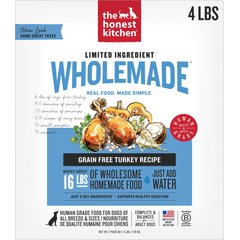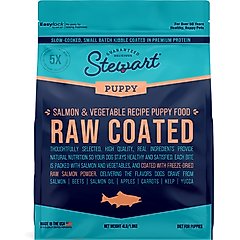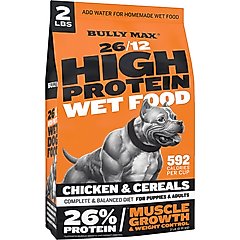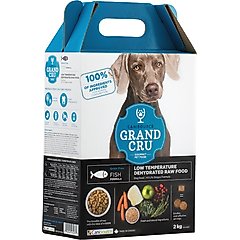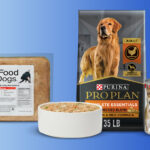The Ultimate Guide to Dehydrated Dog Food
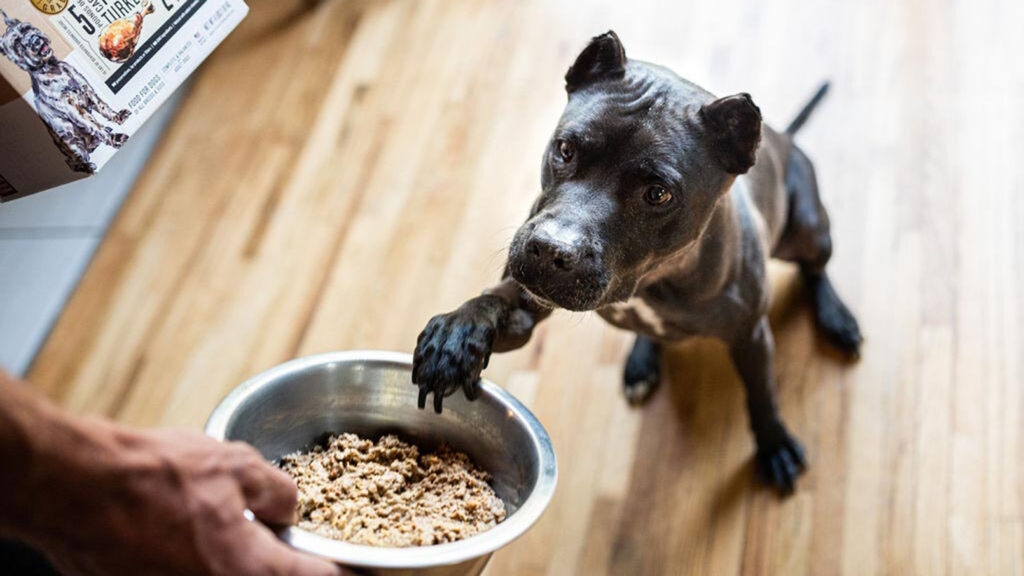
Photo by Chewy
Dog food has come a long way in the last decade, giving pet parents more healthy, convenient options than ever before. One option gaining popularity? Dehydrated dog food.
Dehydrated dog food is a minimally processed, shelf-stable alternative to kibble that’s packed with nutrition and made with whole ingredients. But is it right for your pup? Here’s what to know.
Speak with your veterinarian before changing your dog’s diet.
Key Takeaways
- Dehydrated dog food is a minimally processed dog food made by removing moisture via a slow, low-heat process. It preserves texture, flavor, and nutrients while prioritizing whole foods.
- Dehydrated dog food is shelf-stable and packed with nutrition, but it requires prep and may cost more than kibble.
- The most important thing when feeding your dog is to ensure they’re eating a complete, balanced meal per AAFCO standards.
What Is Dehydrated Dog Food?
Dehydrated dog food is minimally processed dog food that’s slowly had most of its moisture removed through low heat and pressure.
Many dehydrated dog foods are prepared with whole ingredients such as chicken, beef, lamb, or fish, along with real vegetables and grains that are prepared in a way that helps preserve more of the food’s natural nutrients. Unlike traditional kibble—which is often cooked at high temperatures, and may include fillers or preservatives for shelf life—dehydrated food is gently processed to retain flavor, texture, and nutritional value.
This form of dog food typically comes in lightweight, compact flakes or chunks and needs to be rehydrated with warm water before serving.
“The food is heated but not fully cooked,” explains Russell Hartstein, certified pet behaviorist and CEO of Fun Paw Care in Los Angeles. “This partial cooking removes many of the pathogens and microorganisms that are dangerous for dogs eating a raw meat-based diet.”
Should Your Dog Switch to Dehydrated Dog Food?
Dogs don’t need dehydrated food, specifically, but it can be a great option depending on your pet’s needs and your personal preferences.
For example, dehydrated food may be especially beneficial for dogs with sensitive stomachs or food allergies, as the ingredients are usually simpler and closer to whole-food form.
It’s also often a favorite choice of dog parents who want a less-processed alternative to kibble without forfeiting the convenience of shelf-stable food.
Dehydrated Dog Food vs. Freeze-Dried Dog Food
Dehydrated dog food isn’t the same as freeze-dried dog food.
While both are low in moisture and should be rehydrated before eating, freeze-dried dog food is made by flash-freezing the ingredients and then removing moisture through a vacuum. It’s believed the flash-freezing process better preserves the food’s original texture, nutrients, and flavor.
What Are the Benefits of Dehydrated Dog Food?
Dehydrated dog food promises quite a few benefits. Here are some of the perks:
- Enhanced flavor and texture: Dehydrated dog food often has a richer taste and smell compared to kibble, which makes it appealing for picky eaters or dogs with reduced appetites.
- Commercially available: You can find commercially made dehydrated dog food easily. This makes it convenient to buy and a safer option compared to raw food diets. Oklahoma State University (OSU) researchers note that raw food diets can sometimes introduce dangerous bacteria into your dog’s diet, while dehydrated or freeze-dried foods eliminate those pathogens in preparation. It also avoids malnutrition caused by improperly formulated diets prepared at home.
- Shelf-stable: Just like kibble, dehydrated dog food is shelf-stable. Unopened, it can last one to two years, depending on the brand and packaging. Once opened, it typically stays fresh for four to six weeks. After you add water, be sure to use it within a couple of days.
- Prioritizes whole foods: Dehydrated dog food is minimally processed and often formulated without (or with minimal) filler ingredients or extra preservatives. This is a plus for pet parents who prefer a more natural, whole-food approach to Fido’s diet.
- Preserves nutritional value: In addition to being made with whole meats and vegetables, the dehydration process helps preserve additional nutrients compared to kibble. The OSU researchers noted that because traditional kibble is made with high heat, it can affect nutritional bioavailability and even digestibility.
What Are the Downsides of Dehydrated Dog Food?
While the benefits of dehydrated dog food are bountiful, there are some drawbacks to consider, including:
It Requires Additional Preparation
While kibble can be pulled out of the bag and dropped into your pup’s food bowl, dehydrated dog food requires rehydration.
To serve, you must add warm water—usually at a 1:1 ratio—stir and then let stand for five minutes.
It Can Be Expensive
Dehydrated dog food is more expensive and time-consuming to formulate, and it often utilizes high-quality ingredients. This means the price tag is steeper than what you’ll see on commercial kibble.
It’s Unbalanced If Not Complete
Not all dehydrated dog food provides balanced, complete nutrition for your dog. So it’s important to always check that your dog’s food meets the Association of American Feed Control Officials (AAFCO) standards, says Abel Gonzalez, DVM, a veterinarian and clinical director at Dutch, in San Luis Obispo, California.
For example, boutique, grain-free, raw, and ancestor diets are very trendy right now, but some are high in fat, calories, or not balanced.
Make sure you’re buying what your pup needs versus what sounds good on paper. Speak with your vet if you’re ever unsure.
Do Vets Recommend Dehydrated Dog Food?
Many veterinarians give dehydrated dog food the stamp of approval, if it meets your dog’s dietary needs and they enjoy eating it.
What’s most important is that your dog is eating a balanced meal per the AAFCO standards, says Dr. Gonzalez. He adds that “most dogs on complete, commercial diets meet or exceed their nutritional needs.”
It’s also important to portion the food correctly.
What Are the Best Dehydrated Dog Foods?
Not all dehydrated dog foods are created equally. In the same way you use a discerning eye when feeding yourself, it’s important to choose the best foods for your pup.
How To Choose the Best Dehydrated Dog Food
Above all else, look for formulas with clearly labeled whole-food ingredients that you recognize, and make sure the product is labeled as “complete and balanced” according to AAFCO standards. This ensures your dog is getting all their essential nutrients every day.
From here, you can customize your selection based on your dog’s needs and preferences.
Make sure it suits their life stage (puppy, adult, or senior) as well as activity level, and opt for limited-ingredient or grain-free options (that still meet dietary needs) if your dog has certain allergies or sensitivities.
Vet-Recommended Dehydrated Dog Foods
Again, the best dehydrated dog food for your pup is the one that meets nutritional standards, meets their life-stage needs, and satisfies their taste buds.
“Fresh food diets like The Farmer’s Dog and NomNom can be great, so long as portions are customized, and the formulas are complete and AAFCO-approved,” Dr. Gonzalez says.
Here are some vet-recommended dehydrated dog foods:
- For sensitive tummies: The Honest Kitchen Limited Ingredient Diet Turkey Recipe Grain-Free Dehydrated Dog Food
Recommended Product
Recommended Product
- For high-energy dogs: Bully Max 26/12 High Protein Chicken Dehydrated Dog Food
Recommended Product
- For hip and joint support: Stewart Raw Coated Lamb Limited-Ingredient Adult Freeze-Dried Dog Food
Recommended Product
- For itch and redness remedy: Canisource Grand Cru Fish Grain-Free Dehydrated Dog Food
Recommended Product
Should I Give My Dog Dehydrated Dog Food?
Always talk to your veterinarian before switching dog foods. They can help you determine the best dog food for your pet based on their age, breed, energy levels, and health conditions.
Your vet can also confirm the food is complete and balanced and help you make the switch gradually to prevent your dog from experiencing digestive upset, including vomiting or diarrhea, especially if not done gradually.
FAQs About Dehydrated Dog Food
Is dehydrated dog food good for dogs?
Yes, dehydrated dog food that’s been well-prepared and is complete and balanced per AAFCO standards can be a great option for dogs.
Is dehydrated dog food better than kibble?
This depends on the quality of either product and your and your dog’s needs. Dehydrated dog food generally has high nutritional value and is tasty and minimally processed. It’s also shelf stable. However, it must be prepared and can be expensive.
Can I mix dehydrated dog food with kibble?
Speak to your veterinarian about mixing dog foods. Some may provide advice on the best way to go about it.
How do I prepare dehydrated dog food?
To prepare dehydrated dog food, combine warm water with the dehydrated food according to the ratio on the product label (it’s often 1:1). Stir, and let it set for three to five minutes before serving.
Is dehydrated food good for picky eaters?
Yes, it can be a great option for picky eaters because the flavor and smell are often rich and well-preserved.
Can puppies eat dehydrated dog food?
Yes, but choose dehydrated dog food that’s specifically prepared for their life stage. Puppy food is typically higher in calories to meet the demands of their ample energy and growing bodies.
